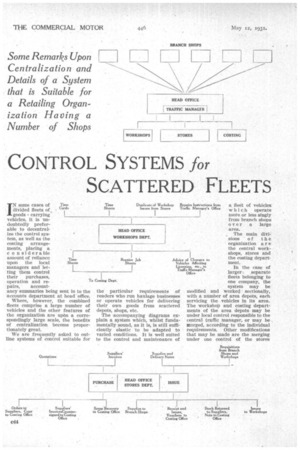CONTROL SYSTEMS for
Page 114

Page 115

If you've noticed an error in this article please click here to report it so we can fix it.
SCATTERED FLEETS
IN some cases of , divided fleets of .
goods carrying vehicles, it is undoubtedly preferable to decentralize the control system, as well as the costing arrangements, placing a considerable amount of reliance upon the local managers and letting them control their purchases, operation and re pairs, account ancy summaries being sent in to the accounts department at head office. Where, however, the combined fleets comprise a large number of vehicles and the other features of the organization are upOn a correspondingly large scale, the benefits of centralization become proportionately great.
We are frequently asked to outline systems of control suitable for the particular requirements of readers who run haulage businesses or operate vehicles for delivering their own goods from scattered depots, shops, etc.
The accompanying diagrams explain a system which, whilst fundamentally sound, as it is, is still sufficiently elastic to be adapted to varied conditions. It is well suited to the control and maintenance of
a fleet or vehicles w it 1 eh operate more or less singly from branch shops over a large area.
The main divisions of the organization a r e the central workshops, stores and the costing department.
In the case of larger _separate fleets belonging to one company, the system may be modified and worked sectionally, with a number of area depots, each servicing the vehicles in its area. The workshop and costing departments of the area depots may be under local control responsible to the central traffic manager, or may be merged, according to the individual requirements. Other modifications that may be made are the merging under one control of the stores
Office
(issues) and workshops and, under another control, the stores (purchases) and costing. Alternatively, the stores, workshop and costing may all come under one control.
This is a system which lends itself readily to extension as well as to mechanized methods of book-keeping. The actual distribution of supplies and spare parts for the vehicles can, in many cases, be made by the lorries or vans employed in effecting urgent deliveries of goods between the main warehouse and the branch shops. Similarly, exchanges of vehicles for overhaul or repairs may be carried out.
In most businesses there is considerable scope for study of the various methods that are available for controlling divided
fleets, and it is thought that the publication of these tables may assist many operators by placing before them the basic details of a typical system.
The main trouble always is to retain full control over the branches without removing responsibility from
Costed Charges to Branch Shops Repairs Instructions to Workshops and Branch Shops
the officers who are remote from head office. Branch managers must be in the position of knowing exactly what theil.* individual vehicles are costing to run and what work they are doing, and they must be able to locate the sources of trouble immediately. This depends mainly upon their being in a position to detect any trouble as soon as it occurs and the evidences of it should be visible, in the ordinary course of the regular returns, to those at headquarters.
It is largely in this respect that so many systems fail. Leakages of one sort or another occur without their being detected for some time, and when they are detected it is difficult to trace the responsibility to the proper quarter.
The vehicles stationed at one branch should be operated on the same general principles as those at another branch, and it must be arranged t ha t
Urgent Repair' s Bead office b e Advice placed in the
position of being able to compare the returns of the various branches, bearing in mind, of course, the different conditions with which the local managers have to cope. This, incidentally, raises t h a important question of standardized fleets, but that is another story—one that is bound up with considerations of commercial policy, differing physical conditions and so forth.
Accident Reports, Claims and Payments Coifing




































































































































































































